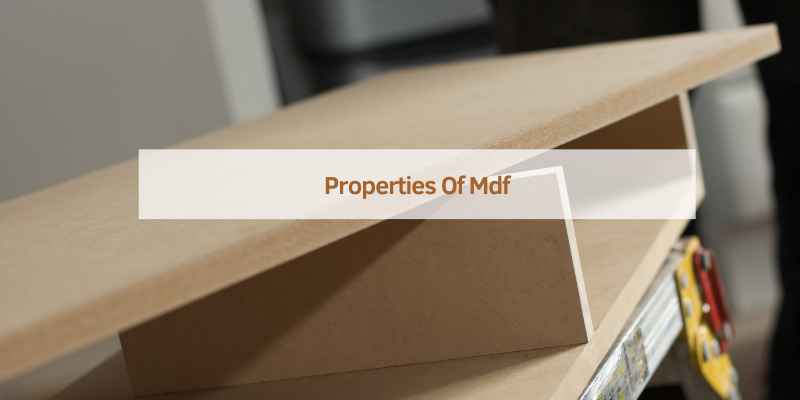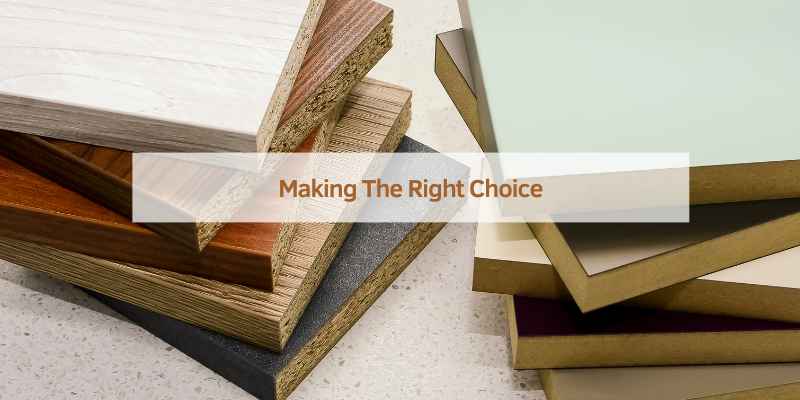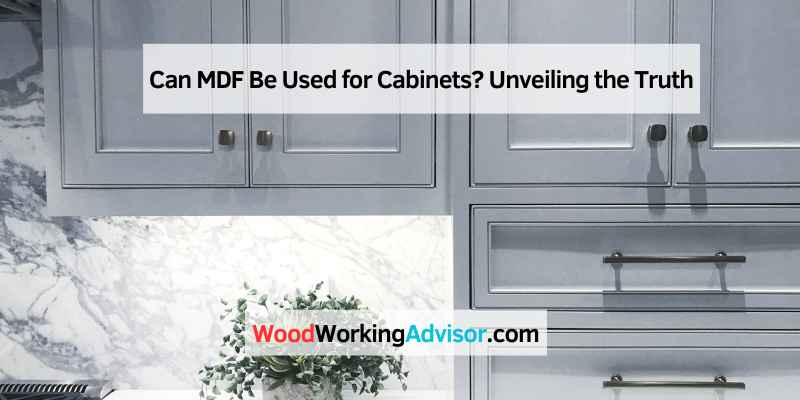Yes, MDF can be used for cabinets. It is a popular choice due to its affordability and smooth surface.
MDF, or Medium Density Fiberboard, is an engineered wood product made by breaking down hardwood or softwood residuals into wood fibers. It is then combined with wax and resin binders, and formed into panels by applying high temperature and pressure.
MDF is favored in cabinet making because it provides a smooth, flat surface that is ideal for painting and laminating. It is also more affordable than solid wood and plywood, making it a cost-effective option. Despite its advantages, MDF is less durable and more susceptible to water damage compared to solid wood, so proper sealing and care are essential.
Properties Of Mdf
Understanding the properties of MDF is crucial for making cabinets. MDF, or Medium Density Fiberboard, is a popular material for this purpose. It offers several advantages that make it a preferred choice for many homeowners and builders.
Material Composition
MDF is made from wood fibers. These fibers are combined with wax and resin binders. The mixture is then heated and pressed to form panels. This process creates a dense, sturdy material.
Unlike solid wood, MDF has no grain. This makes it more uniform. It also means that there are no knots or rings. This uniformity is ideal for a smooth finish. It also makes painting or veneering easier.
Durability And Strength
MDF is known for its durability and strength. It is less likely to warp or crack compared to solid wood. This makes it suitable for areas with varying humidity levels.
MDF can support heavy loads. This is important for cabinets that need to hold kitchenware or other items. It is also resistant to pests. Termites and other insects are less likely to damage MDF.
| Property | Description |
|---|---|
| Density | High, providing strong support |
| Resistance | Resistant to warping and cracking |
| Uniformity | No grain, knots, or rings |
| Finish | Easy to paint or veneer |
These properties make MDF an excellent choice for cabinets. It combines strength, durability, and a smooth finish. This makes it a versatile and reliable material for your cabinetry needs.

Design Flexibility With Mdf
Medium Density Fiberboard (MDF) offers unmatched design flexibility for cabinets. Its versatility makes it a popular choice in modern homes. Let’s explore the various customization options and finishing techniques that make MDF a standout material.
Customization Options
MDF allows for endless customization options. It can be easily cut, shaped, and molded into any design. This means you can create intricate patterns and details on your cabinets. You can also integrate unique hardware for a personalized touch.
- Custom shapes and sizes
- Intricate designs and patterns
- Variety of hardware integration
Using MDF for cabinets means you can achieve a high level of detail that is hard to match with other materials.
Finishing And Painting
Finishing and painting MDF is straightforward and yields excellent results. The surface of MDF is smooth and free of grain, making it ideal for painting. You can apply various finishes to achieve the look you want.
Here’s a simple table to illustrate the finishing options:
| Finish Type | Description |
|---|---|
| Paint | Offers a smooth and vibrant finish |
| Laminates | Provides a durable and stylish look |
| Veneers | Gives a natural wood appearance |
Painting MDF can transform your cabinets into any color or style you desire. This makes it easy to match your existing décor. Finishing MDF with laminates or veneers adds durability and a high-end look.
In summary, MDF offers remarkable design flexibility for cabinets. Its customization options and easy finishing techniques make it a top choice for homeowners.
Mdf In Kitchen Cabinetry
Medium Density Fiberboard (MDF) is a popular choice for kitchen cabinets. It offers a smooth finish and is cost-effective. But is MDF a good choice for your kitchen?
Suitability For Kitchen Use
MDF is strong and durable. It can hold heavy items like dishes and pots. MDF is also easy to paint. This means you can have cabinets in any color you like. Because MDF is smooth, it looks sleek and modern. MDF cabinets can fit in any kitchen style.
Moisture Resistance Concerns
MDF is not naturally water-resistant. It can swell or warp if it gets wet. To use MDF in kitchens, you need a good finish. A good finish can protect MDF from moisture. You can use paint, sealant, or veneer. MDF with a good finish can last a long time. But, you must be careful with water spills. Always wipe spills right away.
| Pros | Cons |
|---|---|
| Cost-effective | Not naturally water-resistant |
| Easy to paint | Can swell if wet |
| Strong and durable | Needs good finish |
| Smooth and sleek look | Careful with water spills |
Cost Implications
When considering materials for cabinets, the cost is a crucial factor. MDF (Medium-Density Fiberboard) is a popular option due to its affordability and long-term value. This section explores the cost implications of using MDF for cabinets.
Affordability Of Mdf
MDF is known for being affordable. It costs less than solid wood. Homeowners on a budget often choose MDF. This material is made from wood fibers. These fibers are compressed with resin. This makes it cheaper to produce.
Here is a comparison of costs:
| Material | Cost per Square Foot |
|---|---|
| MDF | $2-$5 |
| Solid Wood | $10-$15 |
As seen in the table, MDF is significantly cheaper than solid wood. This makes it a great choice for budget-conscious projects.
Long-term Value
MDF offers good long-term value. It is durable and can last many years. MDF resists warping better than solid wood. This makes it a reliable choice for cabinets.
Here are some benefits of MDF:
- Resistant to warping
- Easy to paint
- Less expensive to replace
While MDF is cheaper, it still provides quality. It holds up well over time. This makes it a smart investment for many homes.
In summary, MDF is both affordable and offers long-term value. This makes it a top choice for many homeowners looking to install new cabinets.
Installation Considerations
When considering using MDF for cabinets, understanding the installation process is crucial. MDF, or Medium Density Fiberboard, is a popular choice for cabinetry due to its smooth finish and affordability. Here, we will discuss important installation considerations to ensure a successful project.
Ease Of Handling
MDF is easier to handle compared to solid wood. It is lighter and can be cut with precision. This makes it ideal for cabinet making. MDF’s smooth surface allows for easy painting and finishing.
One of the benefits of using MDF is that it does not have grain. This means it won’t splinter, making it safer to work with. MDF’s uniformity ensures that every piece looks consistent, providing a professional finish.
Required Tools And Techniques
To install MDF cabinets, you will need some basic tools:
- Table saw or circular saw
- Router
- Drill
- Measuring tape
- Clamps
Using the right techniques ensures a smooth installation. Here are some tips:
- Pre-drill holes to avoid splitting the MDF.
- Use carpenter’s glue for a stronger bond.
- Secure joints with clamps until the glue dries.
When cutting MDF, use a fine-tooth blade to achieve a clean cut. Sand the edges to remove any roughness. MDF can absorb moisture, so it’s important to seal the edges to prevent swelling.
Using these tools and techniques will help you achieve a professional finish with your MDF cabinets. Remember to wear a mask when cutting MDF, as it creates a lot of dust.
Environmental Impact
The environmental impact of using MDF for cabinets is a crucial aspect to consider. MDF, or Medium-Density Fiberboard, is a popular material in furniture making. Understanding its sustainability, recycling, and disposal is essential for making eco-friendly choices.
Sustainability Of Mdf
MDF is made from wood fibers, which are often by-products of sawmills. This process reduces waste and maximizes resource use. MDF production uses small, fast-growing trees, which helps in preserving larger, old-growth forests. Sustainable forestry practices are essential in MDF production to ensure minimal environmental impact.
Using formaldehyde-free resins in MDF production can further lower its environmental footprint. Some manufacturers are moving towards these eco-friendly adhesives. This change can significantly reduce harmful emissions.
Recycling And Disposal
Recycling MDF is challenging but not impossible. MDF can be reused in various projects, like creating smaller furniture pieces or art. However, MDF’s recycling process is less straightforward than solid wood.
When it comes to disposal, MDF should not be burned. Burning MDF releases toxic chemicals into the air. Instead, take MDF to specialized disposal facilities. These centers can handle the material safely.
Here are some tips for eco-friendly disposal:
- Donate unused MDF to schools or community centers.
- Repurpose MDF in DIY projects.
- Check local regulations for MDF disposal.
Being mindful of MDF’s lifecycle helps reduce its environmental impact. Make informed choices to protect our planet.
Real-world Applications
Medium-Density Fiberboard (MDF) has become a popular choice for cabinetry. Its versatility and affordability make it ideal for various applications. Let’s explore some real-world examples and expert insights.
Case Studies
Several homeowners have used MDF for their kitchen cabinets with great success. Here are a few case studies:
| Homeowner | Project | Outcome |
|---|---|---|
| Jane Smith | Kitchen Remodel | MDF cabinets painted white, giving a sleek look. |
| John Doe | Bathroom Renovation | MDF used for vanity, proving durable and cost-effective. |
| Emily Johnson | Office Space | Custom MDF cabinets, providing ample storage and modern design. |
These case studies show that MDF is a reliable and stylish choice for cabinetry.
Expert Opinions
Experts in the field agree on the benefits of using MDF for cabinets. John Anderson, a professional carpenter, states, “MDF is perfect for painted finishes. It creates a smooth surface without grain lines.“
Interior designer Sarah Lee adds, “MDF is budget-friendly and offers a range of design possibilities. You can achieve any look you desire.“
Both professionals highlight the versatility and cost-effectiveness of MDF. It stands out as a practical choice for many projects.
Maintenance And Care
Maintaining and caring for your MDF cabinets is essential for their longevity and appearance. These cabinets require regular upkeep to stay in top condition. Proper maintenance ensures that your MDF cabinets remain both functional and aesthetically pleasing.
Cleaning Tips
Regular cleaning helps keep MDF cabinets looking new. Follow these simple steps:
- Dust daily using a soft cloth.
- Wipe spills immediately to prevent staining.
- Use a mild soap solution for deeper cleaning.
Avoid using harsh chemicals and abrasive pads. These can damage the surface of your cabinets. Always dry the surface after cleaning to prevent moisture damage.
Repair And Replacement
Minor repairs can extend the life of your MDF cabinets. Here are some tips:
- Fill small scratches with wood filler.
- Sand the area gently after the filler dries.
- Touch up paint to match the original finish.
Replacing damaged parts is sometimes necessary. For significant damage, consider replacing the affected panel. Use matching materials to maintain a cohesive look.
Proper maintenance and care will keep your MDF cabinets functional and attractive for years to come.
Making The Right Choice
Making the right choice for your cabinet material can significantly impact the look and durability of your project. MDF (Medium-Density Fiberboard) is a popular option. It offers versatility and cost-effectiveness. But is it the right choice for your cabinets? Let’s explore the factors to consider.
Assessing Your Needs
Before choosing MDF for your cabinets, assess your needs. Think about the purpose and location of the cabinets. Will they be in a high-moisture area like a kitchen or bathroom? MDF can swell when exposed to water, making it less ideal for these spaces.
Consider the style and finish you want. MDF is excellent for smooth finishes and painted surfaces. It is less suitable for natural wood grain appearances. Think about your budget. MDF is typically more affordable than solid wood or plywood.
Consulting With Professionals
Consult with professionals to get expert advice on using MDF for your cabinets. They can guide you on the best materials for your specific project. Professionals can also help with installation tips and finishing options.
Ask about long-term durability and maintenance. MDF cabinets can last for years with proper care. But they need to be protected from water and heavy impacts. Professionals can provide valuable insights into these aspects.
| Factors | Considerations |
|---|---|
| Location | High-moisture areas may not be suitable for MDF. |
| Style | MDF is great for painted finishes, not for natural wood looks. |
| Budget | MDF is more budget-friendly than solid wood or plywood. |
| Durability | MDF needs protection from water and heavy impacts. |
- Purpose and location – High-moisture areas vs. dry spaces.
- Style and finish – Painted vs. natural wood appearance.
- Budget – More affordable option.
- Durability – Needs proper care and maintenance.
- Assess your needs.
- Consult with professionals.
- Consider the factors in the table.

Frequently Asked Questions
What Is The Disadvantage Of Using Mdf For Cabinets?
MDF cabinets are less durable than solid wood. They can swell with moisture exposure and are prone to damage.
Is Mdf Strong Enough For Cabinets?
Yes, MDF is strong enough for cabinets. It offers smooth surfaces, easy painting, and good durability. MDF resists warping and cracking, making it a reliable choice for cabinet construction.
Do High End Cabinets Use Mdf?
Yes, high-end cabinets sometimes use MDF for specific components. MDF offers a smooth finish and stability.
How Long Will Mdf Cabinets Last?
MDF cabinets can last 10-15 years with proper care. Regular maintenance and avoiding moisture can extend their lifespan.
Conclusion
MDF can be a great choice for cabinets due to its affordability and versatility. It offers a smooth finish and can be customized easily. With proper care and maintenance, MDF cabinets can be durable and stylish. Consider MDF for your next cabinetry project to combine cost-effectiveness and design flexibility.


